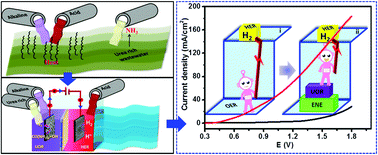Self-supported bimetallic Ni–Co compound electrodes for urea- and neutralization energy-assisted electrolytic hydrogen production†
Abstract
Hydrogen represents one of the most promising renewable energy sources for next generation energy systems, however, its large scale production is high cost and high energy. A proof-of-concept alkaline-acid electrolyzer is reported here that can significantly reduce the amount of electrical energy consumed in electrolytic hydrogen production, implemented by the development of self-supported bimetallic Ni–Co compound electrodes used as the anode and cathode, respectively, where a urea oxidation reaction (UOR) occurs at the alkaline Ni0.67Co0.33(OH)2 nanosheet anode, coupled to the hydrogen evolution reaction (HER) at the acidic Ni0.67Co0.33S2 cathode. The asymmetric-electrolyte electrolyzer can efficiently harvest two kinds of energies, i.e. electrochemical neutralization energy (ENE) and electrochemical urea oxidation energy, to assist electrolytic hydrogen production using waste urea, acid, and base. The as-designed electrolyzer can deliver a current density of 10 mA cm−2 for electrolytic H2 generation with a rather low applied voltage of 0.54 V, with the potential to use up waste urea, acid and base.

- This article is part of the themed collection: 2018 Nanoscale HOT Article Collection


 Please wait while we load your content...
Please wait while we load your content...